Entering the Ethereal Forest
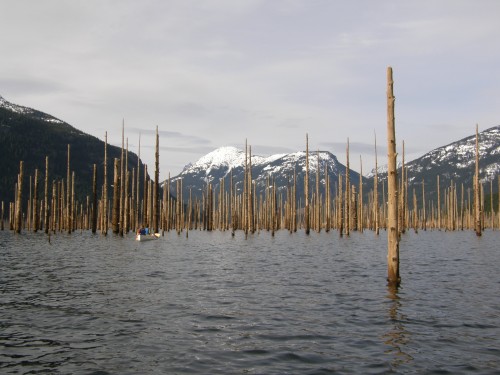
UPDATE MARCH 2014: Join us the weekend of March 28-30 for a brand new Field Excursion: “Ross Lake: Exploring the Drawdown by Canoe” with Institute naturalists and North Cascades National Park geologist Jon Reidel! This class will explore the geologic history of the Ross Lake area during the annual drawdown, a period when the lake is lowered by Seattle City Light and vast new terrain becomes exposed. This unique landscape has been shaped by glaciers, the Skagit River and the Skagit Hydroelectric Project, and a wealth of natural history phenomena emerge every spring when the hidden landscape is revealed.
Info and registration at http://ncascades.org/signup/programs/ross-lake-paddle-the-draw-down or 360-854-2599. Sign up today to guarantee your spot!
* * * * * * * * * * * * * * * * * * * * * * * *
This past weekend dawned sunny and warm in the North Cascades, an unexpected delight for those of us electing to live out the winter in the solitude of the snow-capped peaks and hushed forests around the Environmental Learning Center. Although spring has reportedly been blooming down along the Skagit Valley, our world has remained snowy, rainy, and cold. And if by chance we forget, the closure of Highway 20 just a few miles to our east reminds us it is so. Eager to take advantage of the sun and rare blue skies, a group of 6 of us – staff, grads, and friends – decided to canoe up into the big drawdown of Ross Lake and spend a night under the stars.
We began our 22 mile canoe trip first in the wind-chopped waters of Diablo Lake, some of us (myself included) wondering what we were getting ourselves into. After an hour of paddling, we reached the boat dock at the end of Gorge Canyon, and hitched our canoes to a few wobbly, old, and very janky wheel gurneys in order to portage our boats up and over 540 ft tall Ross Dam to Ross Lake. It was a haul to say the least, and a huffing and puffing adventure at that. On the other side we were greeted by a stunning view of Jack Mountain, and chose to have lunch at the water’s edge, mesmerized by the beauty mountains in every direction.
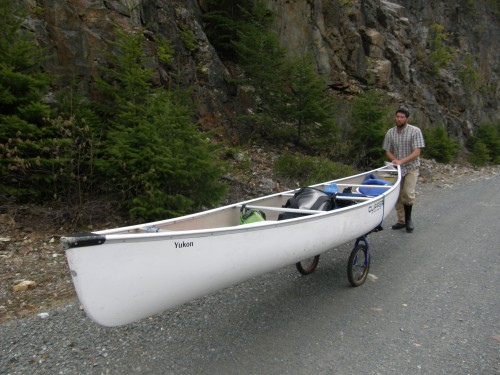 Kai Girard portaging one of our canoes up the service road between Diablo and Ross Lakes. Photo by the author.
Kai Girard portaging one of our canoes up the service road between Diablo and Ross Lakes. Photo by the author.
Surprisingly, the wind died down on Ross Lake, and our group paddled along in excited anticipation for every new peak and vantage awaiting us around each corner. It wasn’t long before Ruby Mountain came into view, a delight for me after months of barely glimpsing the tip of it, concealed as we are so far below along Diablo Lake. The water was glass, and each canoe of two spread out along its width as if responding to the naturalness of its quiet and its calm. It felt good to be out on water, moving ourselves by the strength and consistency of our paddles.
I, for one, felt infinite gratitude for the opportunity to be paddling on Ross in early springtime (or winter – you choose!) with the lake drawn down nearly 80 feet to account for spring snowmelt. The drawdown exposed the denuded slopes of what was once a thriving forest along the upper Skagit River, but is now a vast clearcut of stumps and sandy, detritus-laden substrate. These forests were logged in the mid-1900s in order to build Ross Dam. The lake and forest meet at full water line, concealing what is beneath. But at this time of year adventurers get glimpses into a world that was, and a world that is. Still, the drawdown held its own kind of beauty, the browns and grays of bare side-slopes starkly contrasted with the greens, whites, and blues of mountains and sky. There was also the contrast of fragility and resilience in such a place – a landscape clearcut, and a forest-lake ecosystem now learning to thrive. Such dichotomies invite the ponderer to wonder at the complexities and layers of the world.
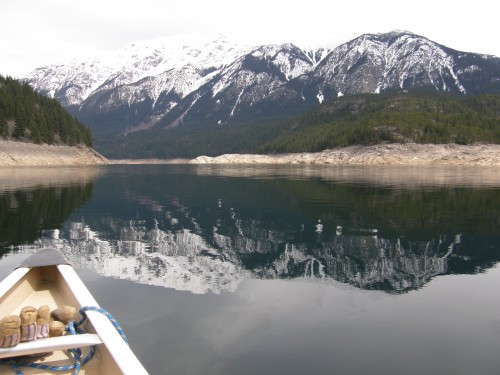 The southeast face of Jack Mountain reflected in the waters of Ross Lake. Photo by the author.
The southeast face of Jack Mountain reflected in the waters of Ross Lake. Photo by the author.
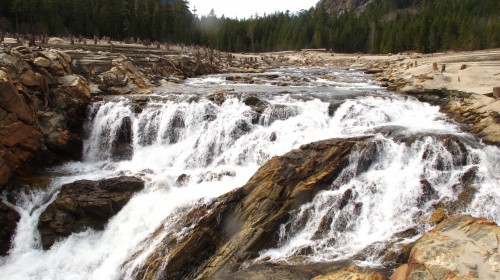 The historic channel of Big Beaver drainage visible only during the drawdown, with stumps dotting its banks. Photo by Kai Girard.
The historic channel of Big Beaver drainage visible only during the drawdown, with stumps dotting its banks. Photo by Kai Girard.
By mid-afternoon we reached Big Beaver Campground, nearly 5 miles north of our put-in at Ross Dam. The dock, usually floating on the water, sat almost carelessly on the lake’s rocky floor well above our heads. We pulled up to the new shoreline, unloaded our gear, and hiked up to camp. The first order of business for us was to follow the roar of what sounded like a waterfall to its source, which turned out to be the historic channel of the Big Beaver River tumbling and turning in its original channel. It was magnificent, and the barren, stumpy shores were juxtaposed against its free-flowing beauty. I couldn’t help wishing that for a moment I was standing on the river’s edge surrounded by its original forest, watching dappled light flicker through the canopy. The banks that stretched before us now felt soft and sandy, like walking on a beach. It appeared that many other creatures were enjoying Big Beaver’s sandy shores too – we saw cat and dog tracks, squirrel and mouse, and some suspiciously large weasel tracks as well.
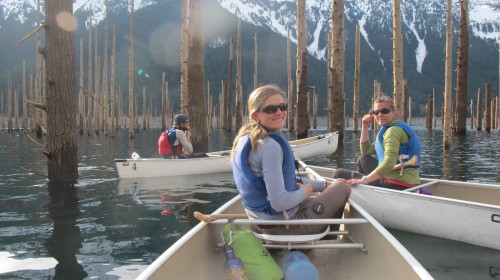 Graduate students Colby Mitchell, Ashley Kvitek, and Christen Kiser paddle through the floating forest. Photo by Kai Girard.
Graduate students Colby Mitchell, Ashley Kvitek, and Christen Kiser paddle through the floating forest. Photo by Kai Girard.
After exploring the area around our campsite for a time, we loaded back into our canoes and headed up lake once more. Our destination was the Picket Fence, a thick mass of topped off trees seemingly suspended in the middle of the lake near Devil’s Canyon. As we paddled nearer, the wall of limbed yet standing trees rose out of the water like ghosts. The lake’s bottom was far enough below us that when we looked down we peered into blackness, yet still these trees were rooted somehow to the earth’s floor. We quite literally were floating through the canopy of an ancient forest, the trees the only remaining relics of what was once a wild river canyon. We were unsure exactly why this particular section of the landscape had not been logged as the rest – perhaps the logging crew had run out of time, perhaps the exact height of the rising reservoir had been unanticipated, perhaps these particular trees had been deemed less valuable than the rest – whatever the reason, in that moment I was grateful they were there. As we maneuvered our boats through the trees, we played around with climbing a few with the sturdiest limbs. There we were, standing in the canopy of an ethereal, floating forest.
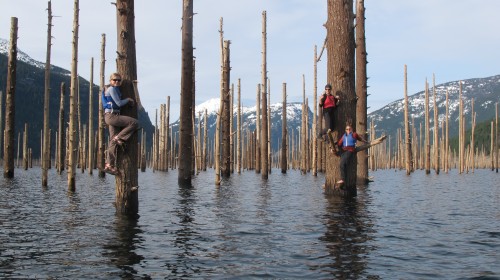 Alex Patia, Katie Roloson, and Christen Kiser climb some tree snags in the Picket Fence on Ross Lake! Photo by Kai Girard.
Alex Patia, Katie Roloson, and Christen Kiser climb some tree snags in the Picket Fence on Ross Lake! Photo by Kai Girard.
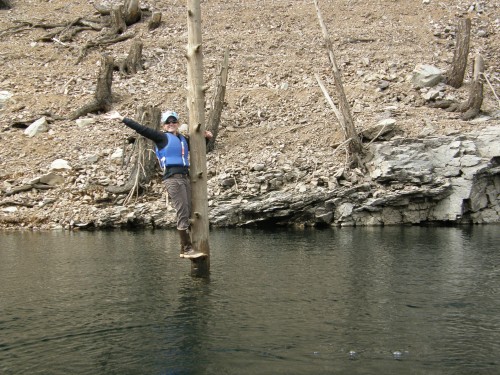 Christen takes a (happy) timeout on an old snag. Photo by Kai Girard.
Christen takes a (happy) timeout on an old snag. Photo by Kai Girard.
As the sun dimmed behind the shadow of mountains, we headed back to camp to cook dinner and spend the evening around a campfire. By bedtime I was tired and happy, and fell sound asleep with the roar of Big Beaver in the background. The next morning again dawned sunny and warm, and we each enjoyed the long paddle back to Ross Dam, a portage up, over, and down to the shores of Diablo Lake, and a shorter canoe to our doorsteps back at the Environmental Learning Center. We were sore and hungry by then, but grateful to have spent a night out under the wild stars of the Upper Skagit.
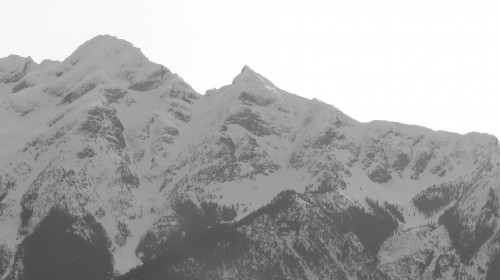 Jack Mountain as seen from our campsite at Big Beaver. Photo by Kai Girard.
Jack Mountain as seen from our campsite at Big Beaver. Photo by Kai Girard.
Leading photo of the expanse of the Picket Fence with Desolation Peak in the background. Photo courtesy of the author.


Awesomeness. 🙂
great article and I loved the pictures. Makes me want to go there and hang out with everyone, it sounds so much fun!!
I loved the pictures of everyone on the trees. You should post on facebook, these pictures.
I loved reading this — the pictures and descriptions of the floating forest and Big Beaver drainage brought the past to life. I’d love to visit as you did during draw-down but it was a treat to read your story. I was up on Ruby while you were canoeing. http://www.flickr.com/photos/jackmc/7055792505/in/set-72157629765231653/
Thank you for sharing of your own adventure on Ruby, Jack! Your pictures are absolutely stunning! While we were paddling, all of us commented on how perfect the bowl on the North side above Happy Creek looked for skiing. What a perfect day for that!